From visual impairment, natural disasters and the negative aspects of AI – students experience a range of problems and manage year-long projects to solve them.
School projects will never be boring at Edgefield. Try these project topics on for size:
An earthquake hits and it is a scene of mayhem and disorder. There is news of missing people who might be trapped under fallen buildings. They have 8 minutes to find or they may not survive. Edgefield’s search team immediately gets to work to survey the surroundings and locate the victims. But how is the small team going to search 8000 square metres within that short span of time to detect signs of human life?
Or how about this one:
A persistent nationwide food scarcity and water shortage problem needs to be solved. How can Singapore be more self-sufficient with urban farming and water harvesting methods?
These are just some of the projects that Edgefield students have designed to solve real world problems as part of the school’s signature Future Ready Programme (FRP) in Secondary 1 and 2. FRP is implemented in a Full SBB mixed-streams form class where students collaborate with one another regardless of their streams.
The programme has a different focus each year.
In Year 1, students embark on FRP Mini-Challenge Projects, where they are challenged to develop solutions for the real-world issues they have identified as a team.
After completing their mini-challenge projects in Semester 1, Y1 students get to choose from a variety of 9 elective modules they would like to take in Semester 2 in order to acquire skills in line with their interests.
The elective modules are also aligned with Learning Journeys to give students the relevant exposure leading up to the Year 2 programme - Future Scenarios Problem Solving.
“The students also use rubrics for self-assessment, and this can be a powerful strategy for learning. The rubrics assess specific success criteria for each of the skills and competencies that would be evaluated. Students need to take stock at each phase and see if they have achieved their milestones. Teachers will also use the same rubrics to evaluate their students’ projects at the end of the action cycle,” said Mdm Chong Wen Yee, the teacher-in-charge of the FRP.
The skills they pick up during their FRP is put to good use almost immediately. After the FRP has concluded in lower secondary, students are challenged to go beyond their comfort zone and use their knowledge, skills and competencies in the school’s ARTasFEST, an event where students nurture their entrepreneurial skills through the sale of food and craft.
For example, while organising the ARTasFEST, students have to think about how to elevate the visitors’ experience and design activities to create a carnival-like atmosphere. They also have to deal with the unglamourous nitty gritty details of logistics planning, such as calculating the number of generators required to run the event.
The school also taps its partnerships with external organisations to develop the programmes that cater to their students’ diverse aptitudes and interests.
“For example, we are working with Jayren Teo, the co-founder of the ASEAN Youth Organization,” said Mdm Chong. “His wealth of experience in entrepreneurial start-ups and youth leadership is invaluable. We seek his input on the FRP so that we can bring out the collaborative spirit in our Edgefielders.”
A closer look at FRP through Saffiyah’s eyes
In FRP, we dealt with real world problems. In Sec 1, the theme was “Urban Planning & Future Cities”. We learned about how Singapore would develop its infrastructure…At first, I thought it would be boring – I mean, I had never thought about architecture or infrastructure before this! But it turned out to be quite interesting, seeing how Singapore adapts its buildings to be more futuristic.
We were given a hands-on experiment to do – to make and code sensors to be rain or light sensors. This simple technology can be applied in so many ways to help Singaporeans in daily life. One of the topics we discussed was how we would design an urbanized version of Coney Island.
In Secondary 2, my group looked at the scenario of Artificial Intelligence taking over the jobs of humans. We had noticed that as a society, we’ve become more reliant on technology in our daily lives. What would happen if machines took over all our jobs? Obviously, there are pros and cons to this scenario. One of the most striking problems is the loss of jobs, and this leads to AI getting a bad rep.
We were given tools to conduct our research. We had to establish the key facts, and use an evaluation matrix based on specific criteria.
My group’s stand was that since AI was unavoidable, we had to educate people about the positive effects of AI. To be honest, our solution wasn’t so exciting, but that as partly driven by the pandemic. Initially we wanted to design IT classes, but because of the pandemic, we opted to have posters instead.
We thought about how these posters would be disseminated. At first, we thought we would print hardcopy posters and put them around the school. But when the pandemic came, we knew this wasn’t possible. So our Plan B was to use an online method of dissemination – Google Forms! We put the posters in a Google Form, embedded in our questionnaire. In many ways this was better as we could track the responses more accurately.
The FRP was challenging. We had to manage this project on top of our studies, but FRP was fun and it was a nice break from our studies. My other challenge was managing my team as the group leader. But we played to each other’s strengths and managed the project with a task list on Google Docs.
Now in Sec 3, I’m participating in another project under the Innovation Programme which is organised by MOE Gifted Branch.
In Term 1, we started with research and collecting data. To understand what a visually impaired person went through, we went for three hours without our glasses. Of course, this was only a fraction of what a visually impaired person has to deal with but the experience evoked a sense empathy in me. I have glasses to fix my eyesight, but the partially blind cannot easily solve their disability with just glasses.
In Term 2, we looked at possible solutions for the problems. My project is about how to educate the public on the struggles of the visually impaired. My group designed a game that incorporated activities and players would have to perform tasks via a box that had in-built coloured lenses to simulate blindness.
Overall, I’ve learned to be to be self-disciplined and self-directed. It’s important to keep to the
deadlines. I’ve learnt to fulfil my role as a leader which means being on top of things so that I can help and
direct my team mates.




